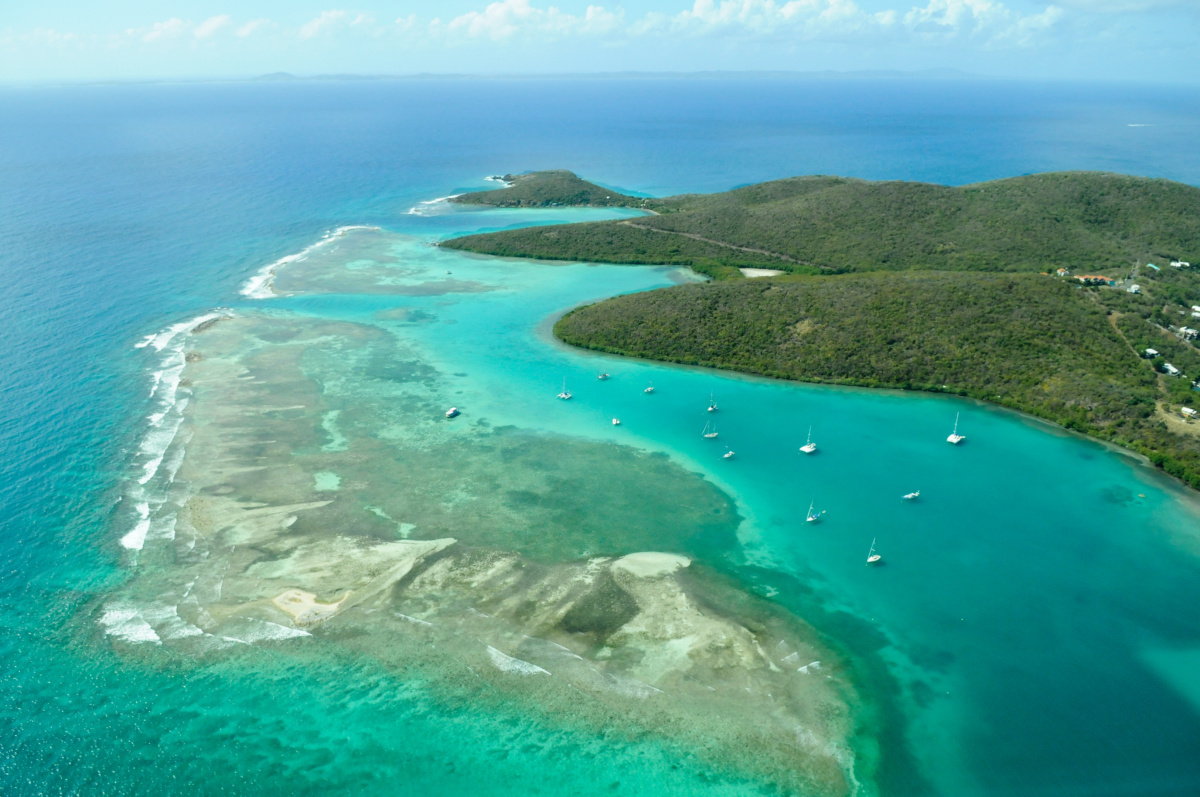Are there snakes in Hawaii? Probably one of the most common questions when planning a trip to this island paradise. Well, yes, there are snakes in Hawaii, but they are nothing you have to worry about. You will not find them in the closet of your hotel room or on the beach where your kids are playing.

The beautiful Crouching Lion hike
There are only two snakes that are fairly common in Hawaii, both elusive and both imported: the Island Blind snake and the Yellow-bellied sea snake.
There are also no poisonous spiders, no crocodiles and no tigers. Except in a zoo. So, get on that plane and have the trip of your life. Hawaii is a paradise.
Snakes in Hawaii
Why there are no more snakes in Hawaii?
Not that you would want snakes in any paradise, but it is strange that in a tropical environment, conducive to enormous diversity of plant and animal life, where so many plants and animals thrive, there are no native snakes. Why?
There is a good reason why and that is the reason why there are no native snakes in Hawaii. The Hawaiian archipelago is located in the Pacific Ocean almost 2,000 miles from the U.S. mainland. All 137 Hawaiian Islands were created millions of years ago by the volcanic activity of underwater volcanoes.

Beautiful aerial view of spectacular Na Pali coast, Kauai, Hawaii
As they have risen from the ocean, the islands were slowly populated by life – plant seeds, birds and animals. All of them had to fly or swim to the islands or were brought by the wind like seeds. Not many of them survived.
Scientists from the University of California say that for example an invertebrate “successfully colonized Hawaii once every 70,000 years, a plant once in every 100,000 years, and a bird once in every million years.” So getting any new species to an isolated island like Hawaii is a very difficult and hit-and-miss process even for birds that can fly over great distances.
This is clearly much more difficult for land animals such as land snakes, so they came to the Hawaiian Islands in different way – they were brought by humans. Some came by accident, by hitchhiking in the cargo of planes or boats, or deliberately, by being brought to be pets, a part of someone’s snake collection.
Only two snakes managed to survive and spread over the islands and are now fairly common and considered almost native: Brahminy Blind Snake and Yellow-Bellied Sea Snake.
Brahminy Blind Snake
Brahminy Blind Snake (Ramphotyphlops braminus) is a tiny black snake native to Asia and Africa but now common all over the world. It is one of the world’s smallest snakes, never growing more than 20 cm or six inches.
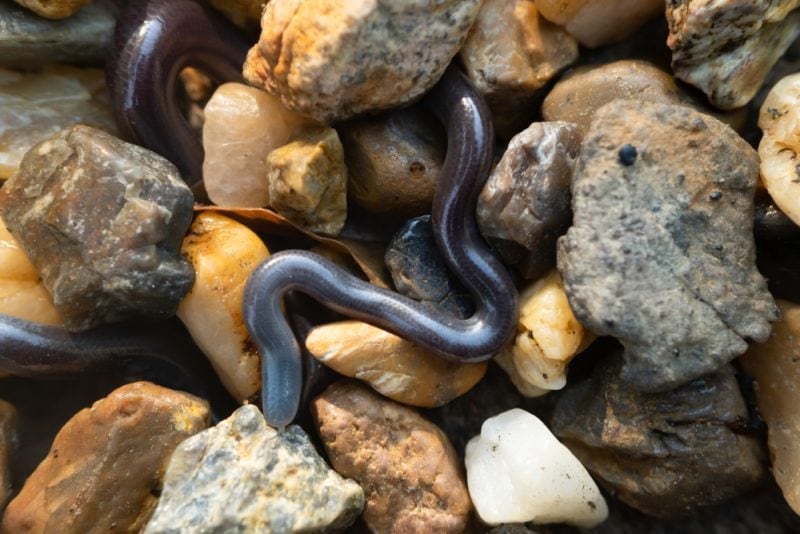
Brahminy blind snake (Ramphotyphlops braminus)
Brahminy snake looks very much like an earthworm, black or dark brown, with head and tail looking pretty much the same. They are almost blind, cannot see fixed images but is sensitive to light.
These type of snakes feed on termites and ants and lives in dark, moist places under logs, humus, and leaves. They can be found most commonly in gardens so it is often called Flowerpot Snake. Brahminy snakes are totally harmless and non-venomous. They have no natural predators – nothing eats them.
You might find it interesting that there are no male Brahminy blind snakes. All are female! They lay eggs that do not have to be fertilized in order to hatch.
It is believed that people brought Brahminy blind snake to Hawaii Islands in the 1930s with the potting soil from the Philippines.
Yellow-Bellied Sea Snake
Yellow-bellied sea snake (Pelamis platurus) is a venomous snake found in tropical oceans all over the world except in the Atlantic Ocean. They are widespread in the tropical parts of the Pacific and Indian Oceans, including Hawaii.
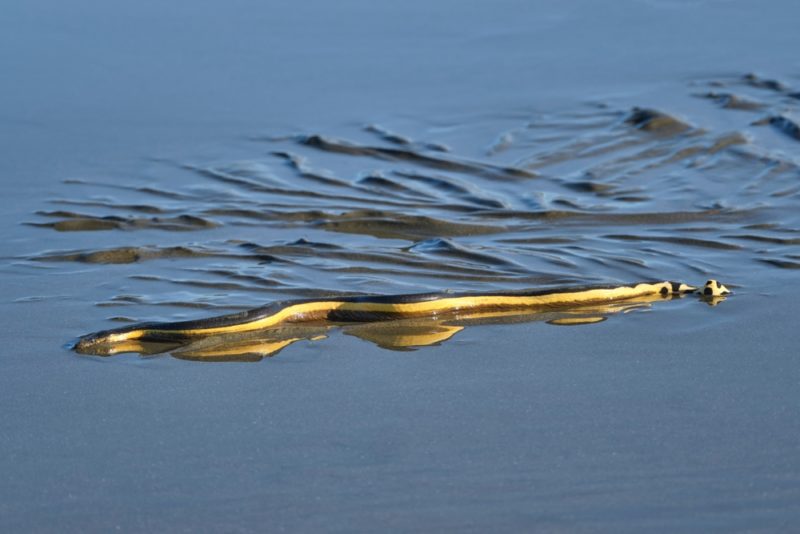
A venemous yellow bellied sea snake washed up on the beach leaves tracks in the wet sand as it tries to slither back to the ocean.
Currents occasionally carry the snakes into temperate waters, but they do not mate or breed there.
The snake’s upper body is black or bluish-brown, and the lower half is yellowish. The yellow tail is paddle-shaped and has a dark bar or spots. It is fairly thin and the average total length is about three feet or one meter.
The Yellow-bellied Sea Snake lives in the open ocean far away from coasts and reefs.
Yellow bellied Sea Snakes have no predators. Their bright color keeps predators away, but it is also possible that the fact that they are highly toxic makes them unpalatable to predators.
Humans are likely to encounter a Yellow-bellied Sea Snake only if an injured or sick animal drifts with the current to the shallow water or to the shore.
They will bite when cornered and their venom, which is highly toxic, can cause paralysis and death if not treated quickly.
The snake is easily recognized because of its bright colors. Although it is highly unlikely, if you see it on the beach or in the water, report it right away to the local authorities. Do not touch it even if it looks dead. They are very fast.
At least, if you are planning on going hiking in Hawaii, you won’t have anything to worry about, however it is always good to stay alert.
What other snakes can be found in Hawaii?
The question: are there snakes in Hawaii becomes more complicated when we take into account snakes that come to the islands due to human stupidity, or by accident. It is justified to call it stupidity considering how dangerous it can be for the islands’ ecosystem. But we will get into that later.
Occasionally, some other snakes are reported on the various Hawaiian Islands. They are always a cause of concern as non-native species have no natural predators in Hawaii and can spread easily and fast.
In our highly mobile world, it is possible for snakes to hitchhike to Hawaii on planes or ships. It is also possible that some snakes that are kept as pets escape or are released into the environment.
Ball python
A pretty, colorful and non-venomous snake, ball python (Python regius) is often kept as a pet in the mainland United States. They are small and cute when they are born. But, as all cute babies, they grow. Adult six feet long ball pythons are not unusual.
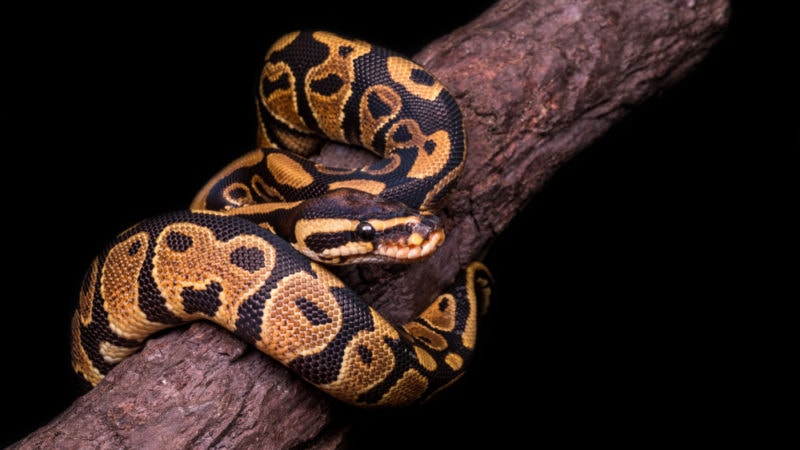
Python regius/ Royal python
They eat birds and small mammals. They are native to Africa where they live in grasslands.
Although keeping ball pythons is strictly illegal in Hawaii, people do reckless things and smuggle these beautiful animals for their collections, although they are aware that they can endanger the island environment if the snakes escape into the environment.
And it happens – they escape or the owners release them because they do not want them anymore or for any other reason. They do that with puppies so why not with snakes.
Ball pythons are occasionally spotted roaming on the various Hawaiian Islands. In 2020, a four-foot-long ball python was caught by a hunter on Oahu Island. He brought it alive to the local humane society.
Ball pythons are not venomous, so they are not dangerous to humans. But since they are not native to Hawaii they have no known predators. They can eat all the birds and small critters until there are no more and devastate the ecological balance on the islands.
The problem is that birds are not aware that snakes are dangerous to them because they are not part of their environment. This is particularly dangerous with the snakes that climb trees, and ball pythons do. So, by the time birds figure out that this thing slithering up the tree is a predator, it is too late.
Every animal plays an important role in the web of life. The loss of any of them can totally collapse the whole system. Losing birds to snakes means too many insects. Everything eats something else, so the consequences go up and down the food chain.
Boa Constrictor
Boa constrictors are also kept as pets in the States as well as in many other countries. There are four subspecies of boas of different colors and patterns. All are native to tropical South America but now can be found all over the world.
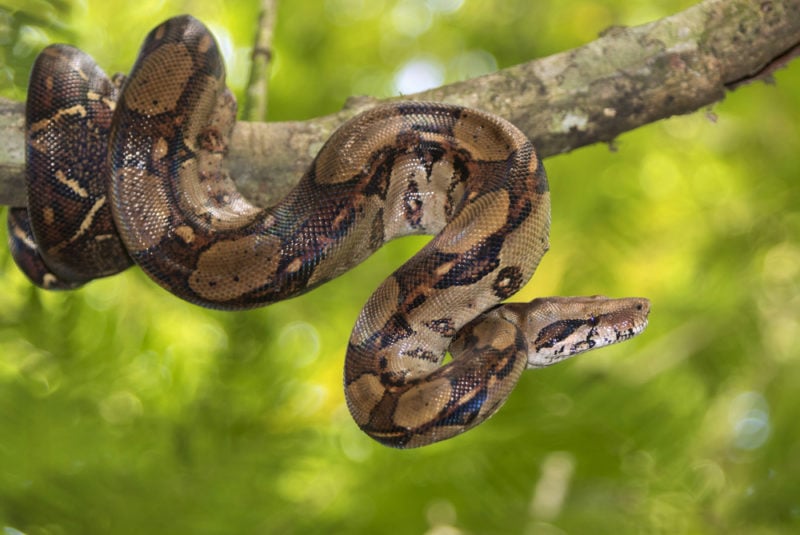
Emperor boa (Boa constrictor imperator) on a tree.
Boas are very attractive, with very distinctive large patterns which differ among subspecies. They can grow to massive proportions and are not venomous and kill by constricting their prey before swallowing it. This kind of snake likes eating small animals including birds and even small house pets.
In 2011, two boas were seen on a farm in Hawaii. One was nine feet long. In 2013, a three-foot-long boa was seen on a Honolulu road. The same year a five-foot-long boa was killed on the Honolulu Pali Highway. A couple of years later, in 2015, a seven-foot boa was confiscated in Nuuanu by the Department of Agriculture.
Lucrative black market in exotic pets is a part of the problem. As long as people want to keep the big snakes as pets there will be someone supplying them, so new boas and other snakes are being brought to Hawaii. The fact that they are so dangerous to the islands’ ecosystem is not preventing people from keeping them, and losing them in the wild, regardless of the possible consequences to the environment.
Recommended reading: 20 Most Amazing Places to Visit Before You Die
Garter Snake
Garter snake is a harmless, small to medium-sized snake from the genus Thamnophis in the family Colubridae. The snakes are native to North and Central America. They greatly differ in the way they look depending on the subspecies, but generally have stripes along the body and sometimes spots as well.
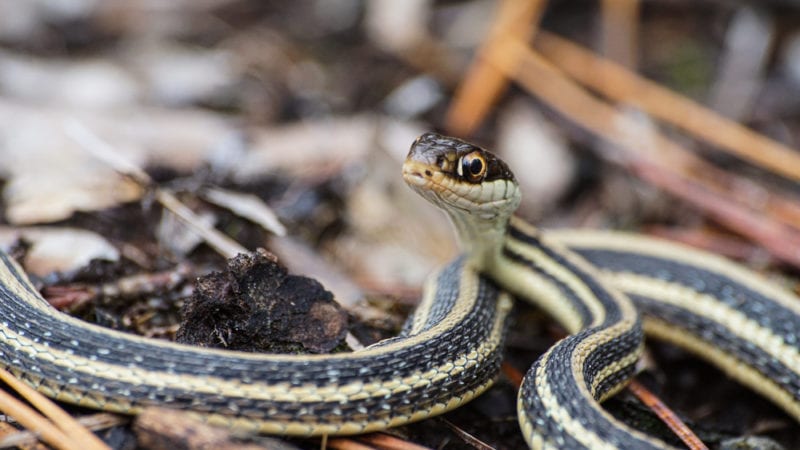
Garter snakes originally came to Hawaii with a shipment of Christmas trees. In 2004, a shipment of Christmas trees came to the store in Hawaii from an Oregon company carrying a hitchhiker – a 13-inch garter snake. Fortunately, the hitchhiker was caught before it could escape into the wild. It happened again in 2020, but that hitchhiker died in transit.
Garter snakes feed on small animals including fish, bugs and amphibians. They have no known predators in Hawaii and if they managed to get a foothold in Hawaii’s lush environment, these normally harmless animals could have caused a catastrophe.
Brown Tree Snake
The brown tree snake (Boiga irregularis), is a nocturnal snake with a yellow to dark brown back, and with cream or yellow underside. Its head is wider than its body, and its eyes are cat-like with vertical pupils.
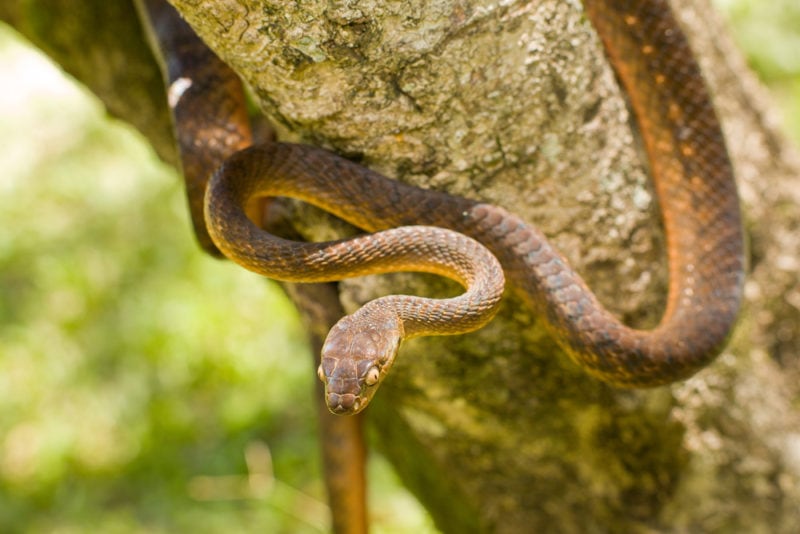
Brown Tree Snake
This snake lives generally in trees but it is seen on the ground as well. It may grow to 3 m (9 feet) but most commonly is about 1-2 m (3-6 feet) long.
Like other snakes, they eat small mammals and birds but have a voracious appetite. Their bite is venomous to humans.
Brown tree snake is native to the South Pacific, the Solomon Islands, New Guinea, and Northern Australia. It came to the States in 1940 by being brought to Guam in plane cargo by accident.
This accident shows just how dangerous these snakes are to an isolated ecosystem, where such an animal has no natural predators.
What happened in Guam?
A warning to all ecosystems in which a new predator arrives with no natural predators. Guam has lost a great proportion of its native animal species to extinction.
It is believed that brown tree snake came originally to Guam in the 1950s on cargo ships coming from New Guinea, where it is native.
Since its arrival, Brown tree snakes multiplied over the next several decades and is today a top predator, sitting on top of the food chain
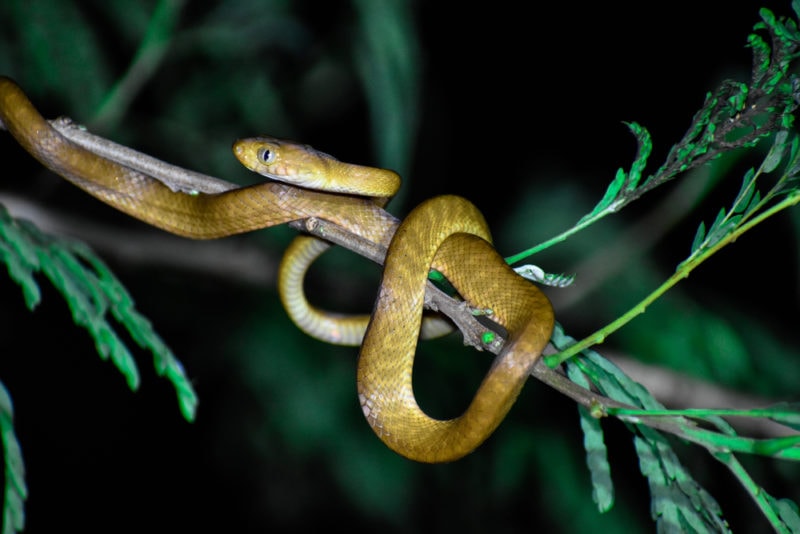
Brown Tree Snake 3 (Boiga irregularis)
The Brown tree snake can have a devastating effect on islands’ closed ecosystems because it is not controlled by predators, competitors, or diseases as it would be in its native range.
Brown tree snakes eat birds, reptiles and bird eggs, lizards, small mammals such as mice, rats and even small domestic pets. By now, these snakes are responsible for the total extinction of 9 out of 13 forest bird species and three species of lizards in Guam.
Other bird species have been drastically reduced in number. Sea birds like terns, shearwaters and noddys do not stop any longer to nest on the island.
The problems just grow from there. After they destroyed their preferred prey, the snakes started feeding on lizards and skinks. Since these animals reproduce faster, they provide ample nutrition for the brown tree snakes, enabling them to sustain the abnormally high number.
After the snakes exterminated birds and lizards, which are insect-eating species, the number of insects in Guam grew dramatically, affecting crop production.
There is more: the Brown tree snakes climb power lines and get into electrical boxes and transformers, causing frequent electrical power outages. Snakes caused over 1600 power outages between 1978 and 1997 in Guam.
Costs to the Guam economy are over $4.5 million per year over a 7-year period, and that is without taking into account damages to transformers and electrical substations.
Are There Sharks In Lake Tahoe | What Else Should I Be Concerned About?
Are there Brown Tree snakes in Hawaii?
Very few, only because the Hawaii Department of Agriculture is making utmost efforts to keep them out of the islands and destroy them when they are found. The only brown tree snakes in Hawaii are those imported to train dogs to root them out.
That is, as far as the government knows. On one hand, these snakes are sly and adaptable. On the other hand, humans are always ready to do irresponsible things such as smuggling them for their snake collections.
The story of Guam is horrible enough to be a sufficient warning to other close ecosystems such as Hawaii. The alternative is unthinkable. The USDA National Wildlife Research Center assessment that the introduction of the Brown Tree snake to Hawaii would cost $1.7 billion per year.
In the meantime, possessing a snake, any snake, in Hawaii is illegal and if caught a person is charged a fine of $200,000, or three years in prison.
Are there venomous snakes in Hawaii?
As we mentioned earlier, one of the two snakes that are now so well established in Hawaii that are considered native, the Yellow-Bellied Sea Snake, is venomous to humans.
But, your chance of encountering this sea snake, which lives in open waters and comes to the shallow water or land only if sick, is pretty low. So, traffic is probably much more worth worrying about than this poisonous critter.
Conclusion
Whether you like snakes or not, you will want to know are there snakes in Hawaii if you are planning a trip there or you are moving to the islands. While the answer is yes, there are snakes in Hawaii, it is not something to worry about.
Of those that are common and considered relatively native, one is a harmless worm-like critter and the other lives in deep waters. So, have fun, enjoy the islands and their tropical diversity in which snakes are not really a part of.


